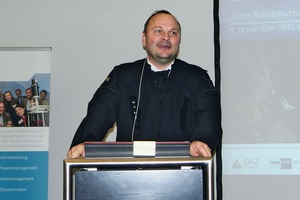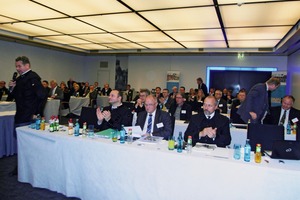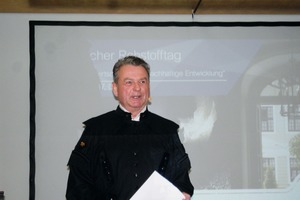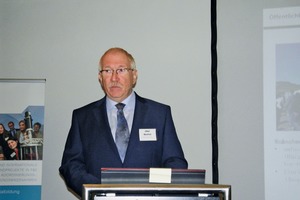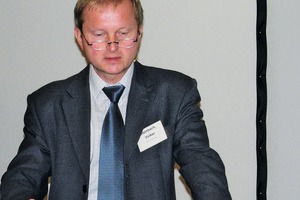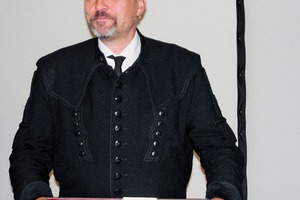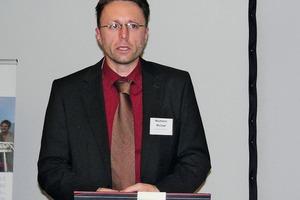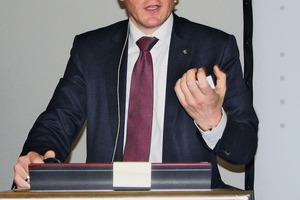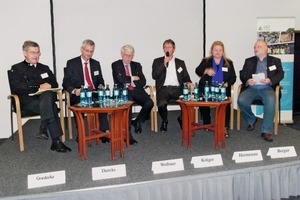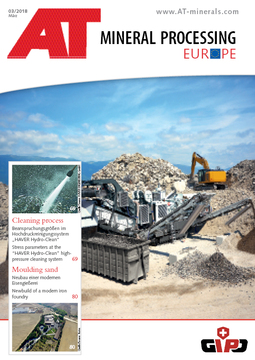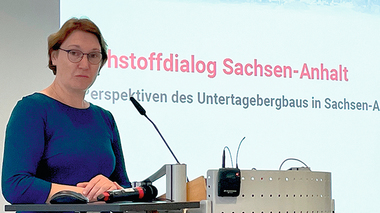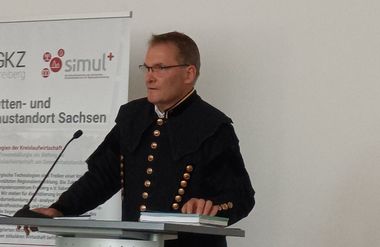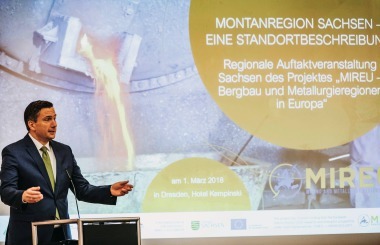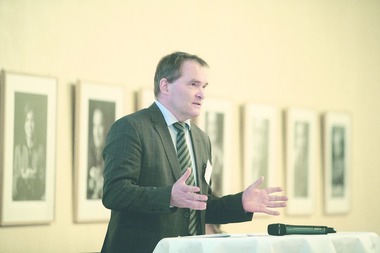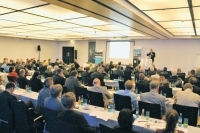“Berggeschrey”* in Saxony getting louder
At the now already traditional venue, the Taschenbergpalais Hotel in Dresden, GKZ Chairman, Dr Hendrik Gaitzsch, welcomed first and foremost the youth, which was represented in some numbers by the students from the BSZ Julius Weisbach, a vocational training centre in Freiberg. He stressed the importance of the mining and geotechnical courses offered at the BSZ to assure the future availability of professionals in this sector. It was, he appealed, never too early to explain to young people about the importance of this branch of industry for our standard of living. The theme of this year’s event, as mentioned in the introduction, clearly underlines that resources management also means mining. “For the general public, this has clearly negative connotations, but if you ask those people living in the affected regions, then a very different picture emerges. It is necessary to continue extracting raw materials and hostility to the industry cannot be the concept,” said Dr Gaitzsch in his plea on behalf of mining. To conclude,
he reminded the attendees that the raw materials industry in history had not only led to wealth, but also to industrial progress and culture. With this in mind, the raw materials industry in Germany was not only a need, but an absolute necessity, and that had to be conveyed to the public.
In his welcoming address, Dr Dirk Orlamünder, Department Manager of Digitalization, Mining at the SMWA, Dresden, expressed a similar sentiment, picking up on the need to introduce young people to jobs in resources management, and emphasized that it was important for this to nurture an awareness of raw materials early on. He too lamented the fact that the term “raw material awareness” wasn’t found among the general public the way it should be and appealed for it to be included in education as early as possible. An important project, he explained, was the ROHSA III programme – the collection, storage and making available of geological data and information, especially related to the geology of raw materials, concerning spars and ores in the Free State of Saxony. Dr Orlamünder pointed out Saxony’s raw materials competence with the relevant players from the resources university Freiberg University of Mining and Technology (TU BAF), Helmholtz Institute of Resource Technology, Freiberg, GKZ, UVR-FIA GmbH and many more and urged to profilerate existing know-how as the challenges of the future weren’t by no means small. The EU’s declared demand for a 20 % increase in the industry share in value creation could not be achieved without a secure basis of raw materials and qualified professionals. He called on Saxony to uphold its reputation as a technology base. Insofar the planned industrial strategy would not be possible without an assured supply of raw materials, but therefore only in combination with the raw materials strategy.
In the plenary paper “Experience in engineering and railway operation in long-distance tunnels – special requirements for the design, engineering and equipment”, Dr Manfred Jäkel GKZ and member BUNG Ingenieure AG, Berlin informed attendees about the time factor. Time periods spanning decades for the planning to building tunnel projects on medium scale were not only down to the need to comply with changes in legal and technical regulations, like, for example, adaption to technical specifications (fire protection) – despite progress in technology. A not to be underestimated effort and cost factor stemmed from the ever longer time that had to be devoted to public relations work. Adding to that, Eckert Fritz from the IFB Institut für Bahntechnik GmbH presented the technical challenges involved in construction of the Fehmarn Belt submersed tunnel – a project comparable with that of the Ore Mountains Tunnel for the planned high-speed rail route between Dresden and Prague. Here too, public relations work played a key role, especially with SMEs presenting their companies and activities at an early stage within the framework of “Industry Days”. With the “Fehmarn Belt Days”, a format was developed that brings together on a broad basis opponents and supporters. Moreover, a key factor in the sense of raw materials extraction is the classification of tunnel excavation material. Waste or recoverable material – that is the question, and it is important to formulate dedicated waste management concepts. Statutory regulations like in Austria and Switzerland where the rock is classified into certain material classes so that a reuse can already be defined in the planning phase were unfortunately not in place in Germany.
A plethora of data was provided by Prof. Dr Volker Steinbach, Federal Institute for Geosciences and Natural Resources (BGR), Hanover, in his talk “Raw materials – basis for technological developments”. He offered his conclusion right at the beginning of the paper: “No high-tech without raw materials” and called for a use of domestic raw materials in a greater extent – for key technologies, too – as well as a responsible handling in general with all raw materials. After all, € 41.8 bill. are spent on raw material imports (70 %). € 7.4 bill. (12 – 13 %) go on domestic raw materials and € 10 bill. (17 %) on raw materials from recycling. Prof. Steinbach pointed out the importance of future and key technologies for Germany and Europe as these were changing demand for global raw materials. A reliable supply of raw materials is essential. For this reason, the BGR commissioned the German Mineral Resources Agency four years ago to compile a report monitoring raw materials, which was explained in detail. On the basis of this study “Raw materials for future technologies 2016” (//www.deutsche-rohstoffagentur.de/DERA/DE/Downloads/Studie_Zukunftstechnologien-2016.pdf" target="_blank" >www.deutsche-rohstoffagentur.de/DERA/DE/Downloads/Studie_Zukunftstechnologien-2016.pdf:https://www.deutsche-rohstoffagentur.de/DERA/DE/Downloads/Studie_Zukunftstechnologien-2016.pdf), current data on the trends in the development of future technologies and their raw materials consumption up to 2035 are available. Here recycling plays a key role. For aluminium, copper and crude steel, high recycling rates are already achieved in Germany. To conclude, he went into the importance of domestic raw materials and stressed in agreement with his professional colleagues that Germany is rich in raw materials (industrial minerals, construction materials, quartz as raw material for the semiconductor industry). A rotor blade for a wind turbine consists, for example, 70 % of quartz. Recycling is important, could not, however, be a substitute for primary extraction. But there were also limitations to recycling, especially there where causally in primary ore smelting – as with the example of copper ore – by-products could not be recovered by means of recycling. The responsible acquisition of raw materials was to be supported by the EU Ordinance on Due Diligence that had come into force in June 2017.
In his paper headed “Germany and its raw materials supply – stale air for domestic mining”, Saxony’s Chief Mining Officer, Freiberg and GKZ Director Prof. Dr Bernhard Cramer warned against saying goodbye to the word “mining”. Although mining in Saxony was an important topic and there is no great country-specific risk for mining in Germany – clear political framework, great certainties in extraction, no transport and supply risks – there existed only an illusionary societal consensus. In the context of the attribution of the word with negative reports, like, for example, mining is damaging, Germany is poor in raw materials, mining has no future in Germany, recycling can substitute mining and supply what we need, it had become a habit to use the word mining in a critical context – as it was a necessary part of the extraction of natural resources, he appealed that mining should not be associated with negative connotations. If our raw materials were only extracted abroad, the problems of mining would only be exported. He added that mining was increasingly no longer seen as an industry and the focus – especially in the case of lignite mining – was limited in the media to discussions on climate and resettlement. With the reference to the example of lignite, but also the non-metallic minerals industry, the speaker demonstrated the capability of Saxony’s mining industry and underpinned these remarks with details on the resumption of mining activities in the Ore Mountains since 2006. Since that year, 50 applications for mining permits had been submitted to the Chief Mining Office. In the Niederschlag mine, where fluorspar has been extracted since 2013, the “Berggeschrey” had therefore been confirmed. At least 15 000 t tin were said to lie in the old Sadisdorf mining works and a comeback was feasible. Cramer is therefore assuming continuous further development and considers the past developments in recent years to have been an adjustment of the situation. Great concern had arisen from the Standortsicherungsgesetz, Germany’s Investment Location Preservation Act (for selection of a final repository for nuclear waste). The development freeze over the whole of Germany with the six explorative steps to determine a site by the German Bundestag constrained the development of new mining projects. He pointed out the long period reserved for the determination process, which can last up to 30 years in some areas, during which work in the mining but also the geothermal sector can only be initiated with special permits. Cramer cited from the defined procedure that as a geological objective for the final repository, specifically crystalline rocks should be singled out. As a result, a large part of Saxony was, he said, subject to the agreement obligation required for this. The statutory framework would therefore be shifted to the disadvantage of the mining of mineral or crystalline resources and therefore in Saxony. Saxony’s State Government was doing its utmost to combat this.
An impressive example of the manifold possibilities to operate useful and sustainable recycling and recover valuable resources from waste and by-products was presented by Dipl.-Ing. Michael Neumann, Director of Research and Development at Nickelhütte Aue GmbH, Aue, in his paper “Contributions of metal recycling to sustainable development”. With reference to many examples of innovative and ecologically cleaner processes in metal recycling (etching solutions from circuit boards, batteries, catalytic converters), he showed that recycling is the key to raw materials sustainability (see also recovery 2/2015, p. 30 ff.). Nickelhütte Aue, which can look back on almost 400 years of uninterrupted company history, offers today primarily special services in pyro- and hydrometallurgical recycling, like that of fat-containing nickel catalysts from margarine fat hardening. The high surface of the catalyst, on which a strongly thermal reaction would take effect during cleaning, requires processing in a rotary tube furnace for oxidation of the nickel. The product formed is sold to steel refineries. Environmentally compatible production of copper sulphate for galvanic purposes is realized with intelligent transport processes at the site. Since 1990 investments totalling over € 100 mill. in flue gas purification at the site has led to a high acceptance amongst the local population in Aue. In this connection, Neumann pointed out Nickelhütte’s extensive sponsoring programme and the company’s support of the local population in community projects. He expressed concerns about the high cost and effort required to obtain permits for the company’s operations, something that used to be done “by the way”. Today, the environmental checks and other issues related to obtaining permits keep five full-time engineers busy, not forgetting the corresponding jobs needed on the authorities’ side.
In his paper on “Resources management and the community in the Ore Mountains”, Dr Alexander Krauss, a representative of Germany’s Federal Bundestag, introduced the impact of mining on civil society and vice versa – as stated further in the title “a traditional symbiosis for the future”. He praised the legally defined ownership model for raw materials in Germany and outlined the political debate in Germany in the party-political fabric. He indicated how important detailed knowledge is in dealings with environment and resources management, and how much party politics can influence the reform of German mining law. In this context, the influence of minorities was, he claimed, not to be underestimated. With regard to the question of mining’s image, there were big differences between opinion actually felt and the opinion conveyed by the media. Besides this, relatively wide disinterest existed in the public in any case. For this reason, further work to raise awareness was all the more necessary. A survey of 1001 people above the age of 14 years by Freiberg University of Mining and Technology had resulted in more than 75 % stating their approval of mining, of the companies, however, more than 80 % expressed the view that mining had negative connotations. This discrepancy had to be eliminated with the early involvement of the public in all projects. Inform – consult / get advice – cooperate, this, he proposed, had to be the approach for successful mining. He conceded that politics had to be assigned corresponding co-responsibility.
In his paper “Biodiversity in mining non-metallic minerals – from individual example to normality”, Oliver Fox from the Mineral Resources Employers Association (UVMB) in Leipzig described the diverse facets of his profession – actually his vocation as a biologist in a mining job. He took the audience on an exciting journey to revitalized quarries and open mines in which, thanks to the creation of small ponds, animal species had settled that can hardly be found otherwise in nature outdoors. So as a consequence of mining, secondary habitats had been created, for example for eagle owls – around 60 % of eagle owls in Germany today nest in quarries. Mines and quarries should not be condemned, as “materials extraction and species conservation complement each other, and nature is dynamic – not static” as the speaker claimed. His work on sites between extraction and nature conservation lay between acceptance and open dislike. He attested that for Germany the goal of conserving biological diversity in the EU – independent of conservation areas – can be considered as fully assured. Yet, the development of discontinued mining areas showed a complex change within the individual provisions of Germany’s Federal Act for the Protection of Nature, as Fox illustrated with reference to the colonization of a reed bed (that had evolved from a former mining area) by the Natterjack toad. Following agriculture, a study is currently underway to establish how far the principles of “good practice” can be made to apply to the extraction of raw materials. The insight that materials extraction and the protection of natural species complement each other would become increasingly rooted among environmental conservationists, too. For companies, legal security was, however, important. Between the two, a differentiation had to be made between group thinking and breaking out of the for and against camps. Dr Wiedenfeld, General Secretary of the UVMB und GKZ Director pointed out the necessity of breaking down fronts and encouraging producers to point out biodiversity in the wake of mining.
Another aspect of mining was examined by Prof. Dr Andreas Berkner, Leipzig Regional Planning Association, with his paper on “Post-mining landscapes as a new opportunity for industry and society”. A “Stone of Dialogue” (in the picture, a boulder set as a monument), placed at a historical site of intensive dispute about the continuation and further development of a potential mining area south of Leipzig immediately after German reunification was not only a symbol of the scientific and social achievement in the recultivation of former lignite mining areas, but also of the regained consensus and the integration of different views in a common creative process. With a view to the discussed exit from lignite mining, he pointed out that the recultivation is part of the business process and a sudden exit would take away the financial resources for this. Too little thought was given to this, but this was a result of an increasingly lamentable asymmetry in awareness, as he put it. This resulted from a large and silent majority versus a well-organized and vociferous minority. Structural change had impacted far more people locally than those who articulated this. After the first structural change in the region following Germany reunification, for Berkner, a second cannot be ruled out in the long term. “While active mining is still needed as a bridge for alternative energies, the end of coal mining is coming!”, Prof. Berkner is sure of that. Former mining landscapes were not better or worse than the original landscapes, but different, and offered new opportunities. One example of this is the remediation of open lignite mines. This has contributed to the changing and upgrading of landscapes. In retrospect, the perception and use of the municipal recreational areas formed for the city of Leipzig by means of recultivation also charged the community with task of dealing with this. Regrettable in this connection was the development that with the newly formed areas nature conservation and nature experience seemed to mutually exclude each other. Putting large areas under protection under Natura 2000 led almost to a totally protected wilderness areas and consequently limited any recreational value.
Following presentation of the papers, five experts faced questions from the moderator, journalist and communications consultant Ralf Krüger, Dresden. The panel discussion stood under the motto “(Why?) has the raw materials sector in Germany a bad image?” Actually, the question had already been asked or at least addressed in almost every paper, and therefore the experts from mining, the raw materials and recycling sector, politics and the press invited to sit on the panel could only add to this and express modified viewpoints. They were agreed that the “Why” in the motto did not need to be in brackets because the raw materials sector in Germany did indeed have a bad image. In answer to the moderator’s first question “What do you expect from the exploratory talks in Berlin and what does a “Jamaica” coalition** mean for the raw materials sector?” the panellist expressed more hopes than expectations. Understandable if you consider the tough, long-drawn-out coalition negotiations. Prof Dr Friedrich-Wilhelm Wellmer, retired President
of the Federal Institute for Geosciences and Natural Resources (BGR), Hanover, pointed out that it was important to create new structures, also with impulses from the government, that can help to assure a German supply of raw materials long term
and actively combat global, politically motivated dictating of prices. It would be desirable if this idea were to be taken up in the coalition negotiations taking place at that time. Secretary of the Mining and Raw Materials Society, Dr Thorsten Diercks saw the raw materials policy in the negotiations as relatively uncritical. Journalist Tilo Berger thought that the negated image of mining particularly with regard to its fundamental importance was already a problem. There were, in his view, too few initiatives on this. With regard to the discussed exit from lignite mining, he remarked that by switching off its coal-fired power plants Germany would not be able to stop a trend, that is further development of coal-fired generation in the world (with up to 1500 coal-fired power generation plants in planning). Antje Hermenau, ex-group chairperson of the Greens in Saxony’s Landtag, viewed the supremacy of China in the production and control of high-tech metals as especially critical and saw here a need for policy-makers to act to combat this. In the high value creation, Dr Diercks saw both a curse and a blessing as with growing prosperity, fears concerning future supply were often lost. “Why is mining disappearing from people’s consciousness?” was another question from the moderator. And here with the involvement of the auditorium it was clearly expressed that the role of the media is often fatal for mining. Fake news is the order of the day. Fears were spread, scientifically founded reports, e.g. on the energy footprint of wind power turbines or electrically powered cars were lacking. When it came to difficult topics such as mining, the role of policy-makers was influenced by fears about the outcome of the next election and they listened too little to scientists about consequences of big decisions before making these (energy turnaround). Courage was needed here (Dr Goedecke). It would, however, be wrong to make just the media responsible, they would continue to play a big part for the image in future, but all the players have their parts to play, which were discussed at length.
In his final remarks, Dr Gaitzsch praised the lively discussion with the important, profound content. “Only adversity leads to change!”, that had been shown by experience, but, at all costs, something should happen beforehand. And the fact remains: the media had a crucial mission. They are not there to make opinion, but to report it.
Conclusion of the event: A lot is happening in mining in Saxony, the Berggeschrey or mining clamour is growing louder, domestic raw materials will gain in importance for the European market, too, and it is time to include knowledge about mining in education and conduct a broad, truthful public relations campaign.
Autoren/Authors:
Dr. Wolfgang Reimer, Geschäftsführer Geokompetenzzentrum Freiberg/Deutschland
Dr. rer. nat. Brigitte Hoffmann, Consulting Kreislaufwirtschaft Umweltschutz, Oberschöna/Deutschland

